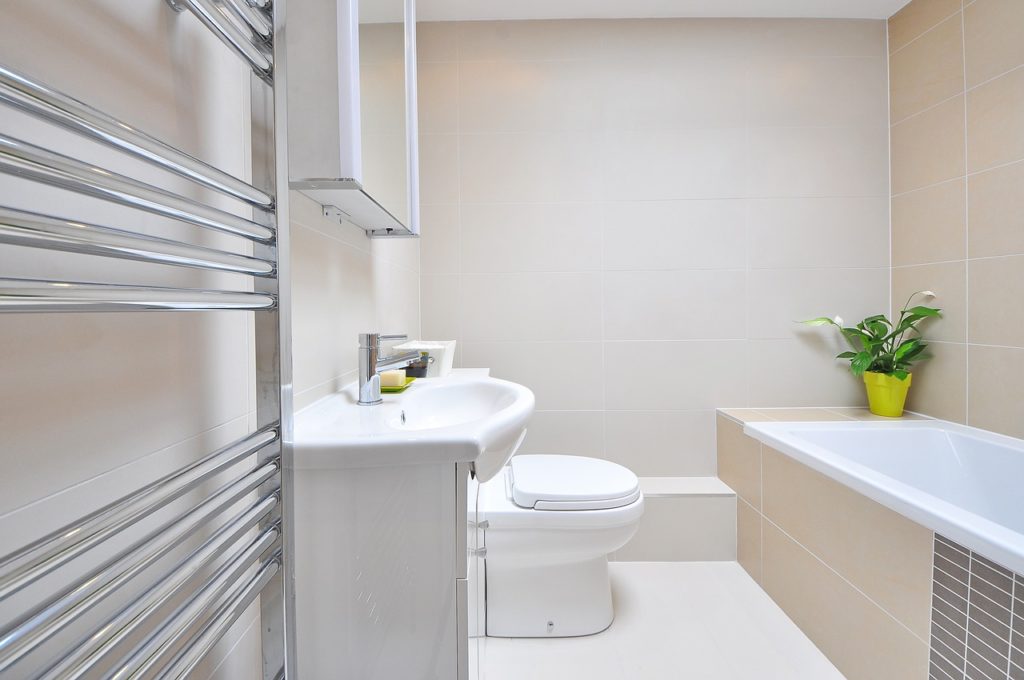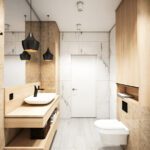Table of Contents
ToggleThe Ultimate Guide to Bathroom Renovation Costs
Renovating a bathroom can be an exciting and rewarding project, but it’s important to understand the costs involved before diving in. In this comprehensive guide, we will explore all the factors that can impact the overall cost of a bathroom renovation, including materials, labor, and additional expenses.
When it comes to bathroom renovation costs, there are several key factors to consider. The size of the space and the complexity of the project can greatly influence the overall budget. Additionally, the materials you choose will also play a significant role in determining the cost. From tiles and flooring to fixtures and fittings, each element comes with its own price tag.
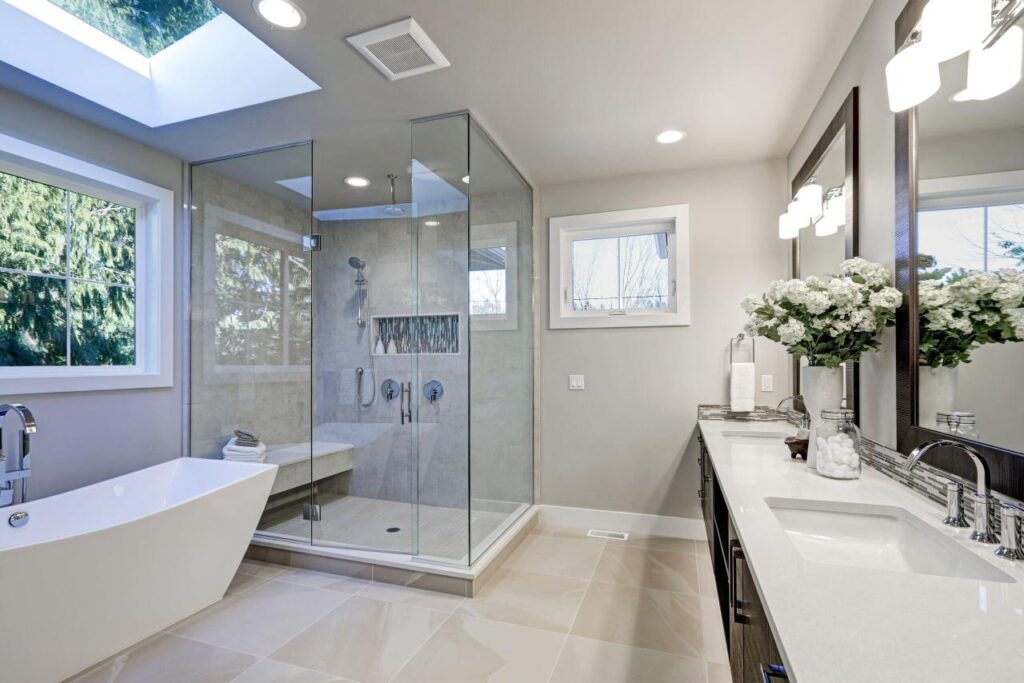
Let’s start by looking at the materials. Tiles and flooring are essential components of any bathroom renovation. The options are vast, ranging from ceramic and porcelain tiles to vinyl and natural stone flooring. The average cost per square foot can vary greatly depending on the material you choose, so it’s important to consider your budget and desired aesthetic when making your selection.
Next, we have fixtures and fittings. Sinks, faucets, showers, toilets, and vanities are all crucial elements of a functional and stylish bathroom. The cost of these items can vary depending on the brand, style, and quality. It’s important to budget for these essentials and choose options that fit within your overall renovation budget.
Cabinetry and storage solutions are also important considerations. Whether you opt for custom-built cabinets or pre-made units, there will be costs associated with their installation. Additionally, don’t forget to account for hardware and installation expenses when budgeting for cabinetry and storage.
Another significant cost to consider is labor and professional services. Bathroom renovation contractors, plumbers, electricians, and other professionals will all play a role in bringing your vision to life. Understanding the average hourly rates for these services will help you estimate the labor costs for your project.
Lastly, it’s important to be aware of hidden costs and additional expenses that can arise during a bathroom renovation. Permits, demolition, disposal fees, and unexpected repairs are all potential costs that can impact your budget. By accounting for these factors from the start, you can avoid any unpleasant surprises along the way.
In this ultimate guide to bathroom renovation costs, we will delve deeper into each of these topics and provide you with practical tips and strategies for saving money on your project. Whether you’re a seasoned DIY enthusiast or prefer to hire professionals, there are ways to achieve your dream bathroom without breaking the bank. So let’s get started and explore the exciting world of bathroom renovations!
Factors Affecting Bathroom Renovation Costs
When planning a bathroom renovation, it is important to consider the various factors that can affect the overall cost of the project. Understanding these factors can help you make informed decisions and budget accordingly. Here are some key factors that can impact the cost of a bathroom renovation:
- Size of the space: The size of your bathroom plays a significant role in determining the cost of the renovation. Larger bathrooms generally require more materials and labor, which can increase the overall cost.
- Complexity of the project: The complexity of the renovation project can also affect the cost. If you plan to make structural changes, such as moving plumbing or walls, it will likely require more time and expertise, resulting in higher labor costs.
- Chosen materials: The materials you choose for your bathroom renovation can greatly impact the cost. High-end materials, such as marble or custom cabinetry, tend to be more expensive than budget-friendly alternatives. It’s important to consider both the aesthetic appeal and the long-term durability of the materials.
By considering these factors, you can better estimate the cost of your bathroom renovation and make informed decisions about where to allocate your budget. Keep in mind that every project is unique, so it’s important to consult with professionals and obtain detailed quotes to get an accurate understanding of the costs involved.
Cost Breakdown: Materials
When it comes to bathroom renovations, one of the key factors that can significantly impact the overall cost of the project is the choice of materials. Understanding the different materials commonly used in bathroom renovations, their average costs, and how they can impact your budget is essential for planning a successful renovation.
Tiles and Flooring: Tiles and flooring are crucial elements in any bathroom renovation. The cost of tiles and flooring can vary depending on the material chosen, such as ceramic, porcelain, natural stone, or vinyl. On average, ceramic tiles can cost between $1 to $20 per square foot, while natural stone tiles can range from $5 to $50 per square foot. It’s important to consider factors like durability, maintenance requirements, and aesthetic appeal when selecting the right tiles and flooring for your bathroom renovation.
Fixtures and Fittings: Bathroom fixtures and fittings include sinks, faucets, showers, toilets, and vanities. The cost of these elements can vary depending on the brand, quality, and style chosen. On average, a basic sink can cost around $50 to $200, while a high-end designer sink can range from $500 to $2,000. Similarly, the cost of faucets, showers, toilets, and vanities can vary significantly. It’s important to carefully consider your budget and prioritize essential fixtures and fittings to ensure a successful bathroom renovation.
Cabinetry and Storage: Installing bathroom cabinets and storage solutions is another important aspect of a bathroom renovation. The cost of cabinetry and storage can vary depending on whether you choose custom-built options or pre-made units. Custom-built cabinets can be more expensive, ranging from $500 to $2,000, while pre-made units can cost between $200 to $1,000. Additionally, you should also consider the cost of hardware and installation when budgeting for cabinetry and storage in your bathroom renovation.
By understanding the different materials commonly used in bathroom renovations and their average costs, you can make informed decisions that align with your budget and desired aesthetic. It’s important to consider factors like durability, maintenance requirements, and overall project goals when selecting materials for your bathroom renovation. By carefully planning and budgeting for materials, you can ensure a successful and cost-effective bathroom renovation.
Tiles and Flooring
Tiles and flooring play a crucial role in the overall aesthetics and functionality of a bathroom renovation. With a wide range of options available, it’s important to consider various factors when choosing the right materials for your project. Let’s explore the different options for bathroom tiles and flooring, their average prices per square foot, and key factors to consider.
When it comes to bathroom tiles, you have a plethora of choices, including ceramic, porcelain, natural stone, glass, and vinyl. Each material has its own unique characteristics and price range. Ceramic tiles are the most affordable option, with an average price of $1 to $5 per square foot. Porcelain tiles, on the other hand, are more durable and can range from $3 to $10 per square foot. Natural stone tiles, such as marble or granite, are luxurious but come with a higher price tag, averaging between $5 and $20 per square foot.
When selecting bathroom flooring, you can opt for materials like vinyl, laminate, hardwood, or even concrete. Vinyl flooring is the most budget-friendly option, with prices ranging from $1 to $5 per square foot. Laminate flooring offers a similar look to hardwood but at a lower cost, averaging between $2 and $8 per square foot. Hardwood flooring provides a timeless and elegant appeal but comes with a higher price range of $5 to $15 per square foot. Concrete flooring offers a modern and industrial look, with prices ranging from $2 to $10 per square foot.
Factors to consider when choosing bathroom tiles and flooring include durability, water resistance, ease of maintenance, slip resistance, and the overall design aesthetic you want to achieve. It’s important to strike a balance between your desired style and your budget. Additionally, consider the size of the bathroom and the amount of foot traffic it will receive to ensure you choose materials that can withstand daily use.
Fixtures and Fittings
When it comes to bathroom renovations, fixtures and fittings play a crucial role in both functionality and aesthetics. These essential elements include sinks, faucets, showers, toilets, and vanities, and they can significantly impact the overall cost of your project. It’s important to understand the costs associated with these fixtures and fittings and how to budget for them effectively.
Sinks: The cost of sinks can vary depending on the material, design, and brand. On average, a basic sink can cost anywhere from $50 to $500, while more high-end options can range from $500 to $2,000 or more. Consider your budget and desired style when choosing a sink for your bathroom renovation.
Faucets: Like sinks, the cost of faucets can vary greatly. Basic faucets can start at around $50, while more luxurious options can exceed $500. Additionally, the cost of installation should also be factored in when budgeting for faucets.
Showers: Showers come in various styles, including walk-in showers, shower-tub combinations, and enclosed shower stalls. The cost of showers can range from $500 for a basic model to several thousand dollars for custom designs with high-end features such as multiple showerheads and intricate tile work.
Toilets: The cost of toilets can vary depending on factors such as flush type, design, and additional features like bidet functionality. Basic toilets can start at around $100, while more advanced and eco-friendly options can cost upwards of $500.
Vanities: Vanities are not only functional but also serve as a focal point in the bathroom. The cost of vanities can vary depending on size, material, and design. Basic vanities can start at around $200, while custom-built or high-end options can cost several thousand dollars.
When budgeting for fixtures and fittings, it’s important to consider both the upfront costs and any additional expenses such as installation fees and plumbing modifications. Researching different options, comparing prices, and setting a realistic budget will help ensure that you choose the right fixtures and fittings for your bathroom renovation without breaking the bank.
Cabinetry and Storage
When it comes to bathroom renovations, one of the key elements to consider is cabinetry and storage. Installing bathroom cabinets and storage solutions can greatly enhance the functionality and organization of your space. However, it’s important to understand the costs involved in this aspect of the renovation process.
There are different options available when it comes to bathroom cabinets and storage. One option is to go for custom-built cabinets, which are designed specifically for your space and can be tailored to meet your specific storage needs. Custom-built cabinets offer a high level of customization and can be made to fit any size or shape of the bathroom. However, they tend to be more expensive compared to pre-made units.
Pre-made units, on the other hand, are a more budget-friendly option. These cabinets come in standard sizes and designs and are readily available in home improvement stores. While they may not offer the same level of customization as custom-built cabinets, they still provide ample storage space and can be a cost-effective solution for many homeowners.
In addition to the cost of the cabinets themselves, it’s important to factor in the additional expenses for hardware and installation. Hardware such as handles, knobs, and hinges can add up in terms of cost, especially if you opt for high-quality materials. Installation costs will also vary depending on the complexity of the project and whether you choose to hire professionals or tackle the installation yourself.
Overall, understanding the costs involved in cabinetry and storage is crucial when planning your bathroom renovation budget. Whether you decide to go for custom-built cabinets or pre-made units, make sure to consider the additional expenses for hardware and installation. By carefully considering your options and budgeting accordingly, you can create a functional and stylish bathroom storage solution that meets your needs and fits within your budget.
Labor and Professional Services
Labor and professional services play a crucial role in the overall cost of a bathroom renovation project. It’s important to understand the average hourly rates for different professionals involved in the process, such as bathroom renovation contractors, plumbers, electricians, and other tradespeople. By having a clear understanding of labor costs, you can effectively estimate and budget for your project.
When it comes to labor costs, it’s essential to consider the complexity of your renovation project. More complex renovations, such as complete bathroom overhauls or structural changes, may require more specialized professionals, which can increase labor costs. On the other hand, simpler projects like replacing fixtures or updating the flooring may require less specialized labor and can be more cost-effective.
Here is a breakdown of the average hourly rates for some common professionals involved in bathroom renovations:
| Professional | Average Hourly Rate |
|---|---|
| Bathroom Renovation Contractor | $50 – $100 |
| Plumber | $75 – $150 |
| Electrician | $80 – $150 |
| Tiler | $50 – $100 |
| Painter | $40 – $80 |
It’s important to note that these rates can vary depending on factors such as location, experience, and the scope of the project. To estimate labor costs for your specific project, you can multiply the average hourly rate by the estimated number of hours each professional will spend on the job. This will give you a rough idea of the labor expenses you can expect.
By understanding labor costs and estimating them accurately, you can plan your bathroom renovation budget more effectively and avoid any surprises along the way. It’s always a good idea to consult with professionals and get multiple quotes to ensure you are getting the best value for your money.
Hidden Costs and Additional Expenses
When it comes to bathroom renovations, it’s important to be aware of the hidden costs and additional expenses that can arise during the process. These costs are often overlooked and can quickly add up, impacting your overall budget. By understanding and accounting for these expenses, you can ensure that you’re prepared and avoid any surprises along the way.
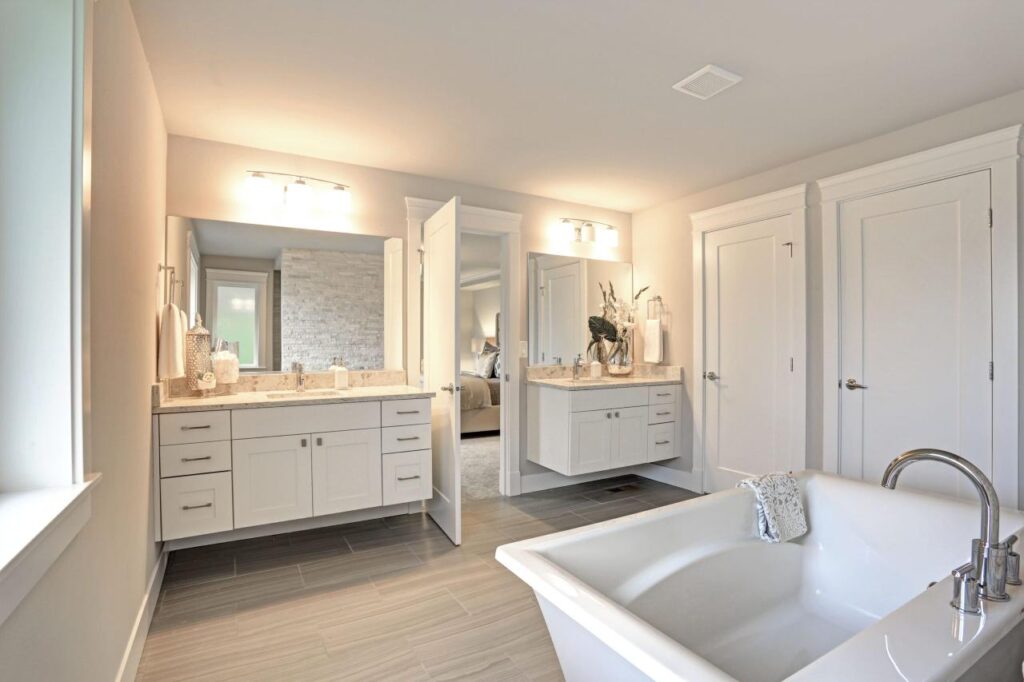
One of the common hidden costs in bathroom renovations is obtaining permits and meeting legal requirements. Depending on your location and the scope of your project, you may need to obtain permits for certain renovations. These permits come with fees that can vary, so it’s important to research and budget for them accordingly.
Another potential hidden cost is demolition. If you’re planning to make significant changes to your bathroom layout or remove existing fixtures, you’ll likely need to demolish certain areas. Demolition can be a messy and time-consuming process, and you may need to hire professionals or rent equipment to get the job done. It’s essential to factor in the cost of demolition when planning your budget.
Disposal fees are often overlooked but can be a significant expense during a bathroom renovation. When you’re tearing out old materials and fixtures, you’ll need to dispose of them properly. This may involve hiring a waste removal service or renting a dumpster, both of which come with their own costs. It’s important to consider these fees when estimating your overall budget.
Unexpected repairs are another potential hidden cost. Once you start renovating your bathroom, you may uncover hidden issues such as plumbing or electrical problems. These repairs can add to your expenses, so it’s important to have a contingency fund in your budget to cover any unforeseen repairs that may arise.
By being aware of these hidden costs and additional expenses, you can plan your bathroom renovation budget more effectively. It’s always a good idea to set aside some extra funds for unexpected expenses and to do thorough research to ensure that you’re aware of all the potential costs involved. With proper planning and budgeting, you can achieve your dream bathroom without any financial surprises along the way.
Permits and Legal Requirements
When planning a bathroom renovation, it’s essential to understand the potential costs associated with obtaining permits and meeting legal requirements. Depending on your location and the scope of the project, there may be specific regulations and guidelines that need to be followed. Failing to comply with these requirements can result in fines and delays, so it’s crucial to factor in these costs when budgeting for your renovation.
Obtaining permits is often necessary for major bathroom renovations, especially if you’re making structural changes or altering plumbing and electrical systems. The cost of permits can vary depending on your location and the complexity of the project. It’s important to research the specific requirements in your area and budget accordingly.
In addition to permits, there may be other legal requirements that need to be met, such as compliance with building codes and regulations. This may involve hiring professionals, such as architects or engineers, to ensure that your renovation meets all the necessary standards. These additional services can add to the overall cost of your project.
To avoid any surprises or setbacks, it’s recommended to consult with local authorities or a professional contractor who is familiar with the legal requirements in your area. They can provide guidance on the necessary permits and help you navigate through the process, ensuring that your renovation is compliant with all regulations.
Disposal and Removal
Disposing of old materials and debris is an important aspect of any bathroom renovation project. It is essential to properly remove and dispose of these items to ensure a clean and safe working environment. However, it is also important to consider the costs involved in this process.
When it comes to disposal and removal, there are two main options to consider: hiring a waste removal service or renting a dumpster. Both options have their advantages and disadvantages, and the choice depends on the specific needs of your renovation project.
- Hiring a waste removal service: This option involves hiring a professional waste removal company to handle the disposal of old materials and debris. These companies have the necessary equipment and expertise to efficiently remove and dispose of waste. The cost of hiring a waste removal service can vary depending on factors such as the amount of waste, the distance to the disposal site, and any additional services required.
- Renting a dumpster: Renting a dumpster is another option for disposing of old materials and debris. This involves renting a large container that is placed on your property and filled with waste. Once the renovation is complete, the dumpster is picked up and the waste is taken away. The cost of renting a dumpster can vary depending on factors such as the size of the dumpster, the duration of the rental, and any additional fees for disposal.
When deciding between hiring a waste removal service and renting a dumpster, it is important to consider the specific needs of your renovation project. If you have a large amount of waste or if the waste needs to be removed quickly, hiring a waste removal service may be the best option. On the other hand, if you have space on your property and prefer to have more control over the disposal process, renting a dumpster may be a better choice.
Ways to Save on Bathroom Renovation Costs
When it comes to bathroom renovation, finding ways to save on costs can be a top priority. Fortunately, there are several practical tips and strategies that can help you reduce the overall expenses of your project. Here are some ways to save on bathroom renovation costs:
- Consider DIY options: Taking on certain tasks yourself can significantly cut down on labor costs. Simple tasks like painting, installing fixtures, or even tiling can be done with some basic skills and the right tools.
- Shop for bargains: Look for sales, discounts, and clearance items when purchasing materials and fixtures for your bathroom renovation. Many home improvement stores offer special deals on discontinued or overstocked items, allowing you to get quality products at a fraction of the original cost.
- Prioritize essential upgrades: Instead of completely overhauling your entire bathroom, focus on the essential upgrades that will make the biggest impact. Consider what aspects of your bathroom are in dire need of improvement and allocate your budget accordingly.
By implementing these cost-saving strategies, you can make your bathroom renovation more affordable without compromising on quality. Remember, it’s important to strike a balance between cost and value, ensuring that you’re getting the most out of your investment.
DIY vs. Hiring Professionals
When it comes to bathroom renovations, one of the biggest decisions you’ll face is whether to tackle the project yourself or hire professionals. Both options have their advantages and disadvantages, so it’s important to carefully evaluate your skills, time availability, and the complexity of the project before making a decision.
DIY Bathroom Renovations:
- Pros: One of the biggest advantages of DIY bathroom renovations is cost savings. By doing the work yourself, you can eliminate labor costs and potentially save a significant amount of money. Additionally, DIY projects can be rewarding and give you a sense of accomplishment.
- Cons: DIY renovations require time, effort, and a certain level of skill. If you’re not experienced in home improvement projects, you may encounter challenges and make mistakes that could end up costing more in the long run. It’s also important to consider your time availability and whether you’re willing to invest the necessary hours to complete the renovation.
Hiring Professionals:
- Pros: Hiring professionals for your bathroom renovation can provide peace of mind and ensure high-quality results. Professionals have the expertise, tools, and experience to handle complex projects efficiently. They can also offer valuable advice and recommendations based on their industry knowledge.
- Cons: The main downside of hiring professionals is the cost. Labor costs can significantly increase the overall budget of your renovation. Additionally, you may need to coordinate schedules and rely on the availability of contractors, which can cause delays in the project timeline.
Ultimately, the decision between DIY and hiring professionals depends on your individual circumstances. If you have the necessary skills, time, and confidence to take on a bathroom renovation, DIY may be a cost-effective option. However, if you prefer to leave the work to experts or have a complex project that requires specialized knowledge, hiring professionals can ensure a smooth and successful renovation.
Budget-Friendly Design and Material Choices
When it comes to bathroom renovation, achieving your desired aesthetic doesn’t have to mean breaking the bank. By making budget-friendly design and material choices, you can transform your bathroom into a stylish and functional space without compromising on quality. Here are some cost-effective options to consider:
- Alternative Materials: Instead of splurging on expensive materials, consider more affordable alternatives. For example, opt for porcelain tiles instead of marble or quartz countertops instead of granite. These alternatives can offer a similar look and feel at a fraction of the cost.
- Creative Solutions: Get creative with your design choices to save money. For instance, instead of installing a full wall of expensive mosaic tiles, use them as accents or create a focal point with a smaller area. This way, you can achieve a high-end look without the hefty price tag.
- Refurbish and Repurpose: Before completely replacing fixtures and fittings, consider refurbishing or repurposing them. A fresh coat of paint or new hardware can breathe new life into old cabinets or vanities. This not only saves money but also adds a unique touch to your bathroom.
- Shop Smart: Take the time to shop around and compare prices. Look for sales, discounts, and clearance items to score great deals on bathroom fixtures, accessories, and materials. Online marketplaces and home improvement stores often offer competitive prices and promotions.
- Do-It-Yourself (DIY): If you have the skills and time, consider tackling some of the renovation tasks yourself. DIY projects can significantly reduce labor costs. However, be realistic about your abilities and seek professional help for complex plumbing or electrical work.
By exploring these budget-friendly design and material choices, you can create a stunning bathroom that reflects your personal style without exceeding your budget. Remember, it’s all about making smart choices and finding creative solutions to achieve the bathroom of your dreams.
Timing and Scheduling
When it comes to bathroom renovation, timing and scheduling play a crucial role in saving money and ensuring a smooth and efficient project. By carefully planning and coordinating tasks, you can take advantage of off-season discounts and optimize the use of resources, ultimately reducing costs.
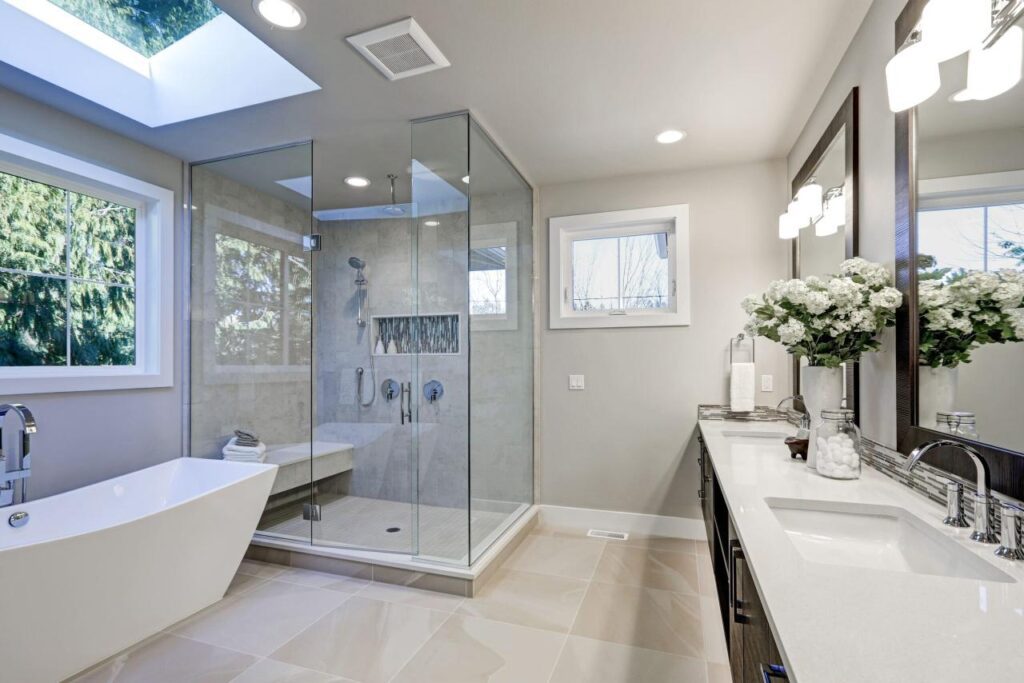
One way to save money on your bathroom renovation is to schedule the project during the off-season. Contractors and suppliers often offer discounts and promotions during slower periods, such as winter or early spring. By planning your renovation for these times, you can take advantage of lower prices on materials and labor, potentially saving a significant amount of money.
In addition to timing, efficient scheduling of tasks can also help save costs. By coordinating multiple tasks and tradespeople, you can minimize downtime and ensure a more streamlined workflow. For example, if you’re replacing the flooring, it makes sense to schedule the installation of new plumbing fixtures and electrical work simultaneously. This way, you can avoid additional labor costs and potential delays caused by having to revisit the same area multiple times.
Another aspect of timing and scheduling is proper project management. By creating a detailed timeline and sticking to it, you can avoid unnecessary delays and associated costs. It’s essential to communicate effectively with your contractors and ensure that everyone is on the same page regarding the project’s schedule and deadlines.
Furthermore, consider the lead time for materials and fixtures. Some items may have longer delivery times, so it’s important to order them well in advance to avoid delays and potential rush fees. By planning ahead, you can also take advantage of sales and promotions on the materials and fixtures you need for your bathroom renovation.
Overall, by paying attention to timing and scheduling, you can optimize your bathroom renovation project, save money, and ensure a successful outcome. From taking advantage of off-season discounts to coordinating tasks efficiently, careful planning can make a significant difference in the overall cost and timeline of your renovation.
Frequently Asked Questions
- Q: How much does a bathroom renovation typically cost?
A: The cost of a bathroom renovation can vary greatly depending on several factors, such as the size of the space, the complexity of the project, and the materials chosen. On average, a basic bathroom renovation can cost anywhere from $5,000 to $15,000, while a more high-end renovation can range from $15,000 to $40,000 or more.
- Q: What materials are commonly used in bathroom renovations?
A: Common materials used in bathroom renovations include tiles for flooring and walls, fixtures and fittings such as sinks, faucets, showers, toilets, and vanities, as well as cabinetry and storage solutions. Each material choice can impact the overall budget of the project.
- Q: Should I hire professionals or do a DIY bathroom renovation?
A: The decision to hire professionals or do a DIY renovation depends on your skills, time availability, and the complexity of the project. While a DIY renovation can save money, it may require more time and effort. Hiring professionals ensures expertise and may result in a faster and more efficient renovation.
- Q: Are there any hidden costs I should be aware of?
A: Yes, there are often hidden costs that can arise during a bathroom renovation. These can include permits and legal requirements, disposal and removal fees, as well as unexpected repairs. It’s important to account for these potential costs in your budget.
- Q: How can I save on bathroom renovation costs?
A: There are several ways to save on bathroom renovation costs. Consider doing some tasks yourself, shopping for bargains on materials and fixtures, and prioritizing essential upgrades. Additionally, careful planning and timing can help you take advantage of off-season discounts and coordinate tasks efficiently.
